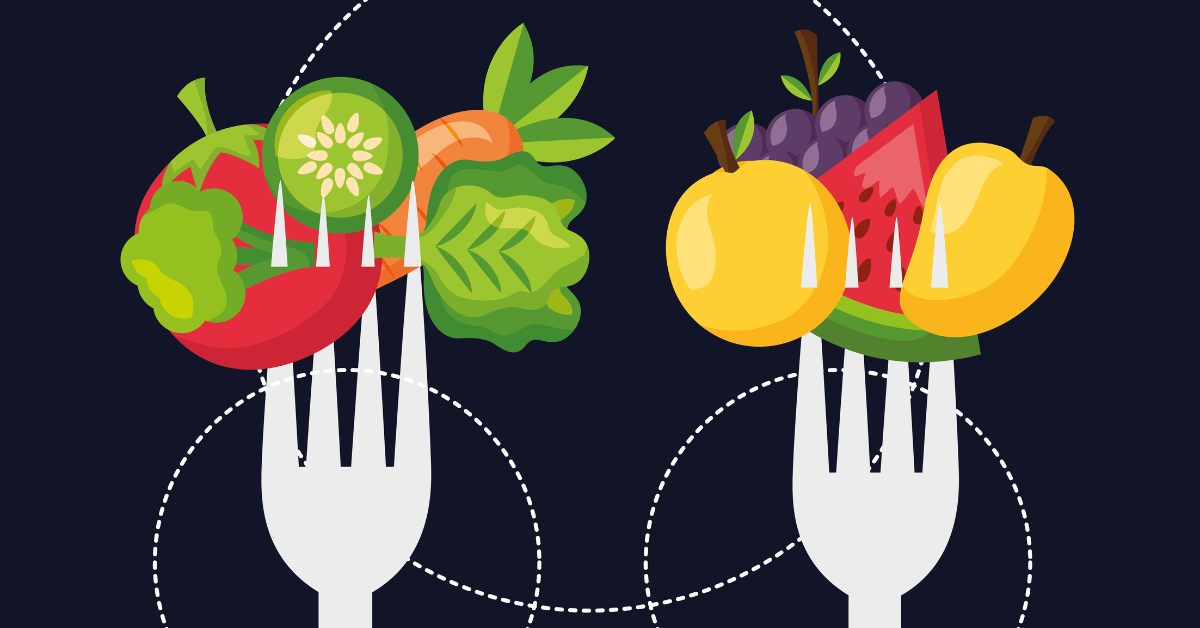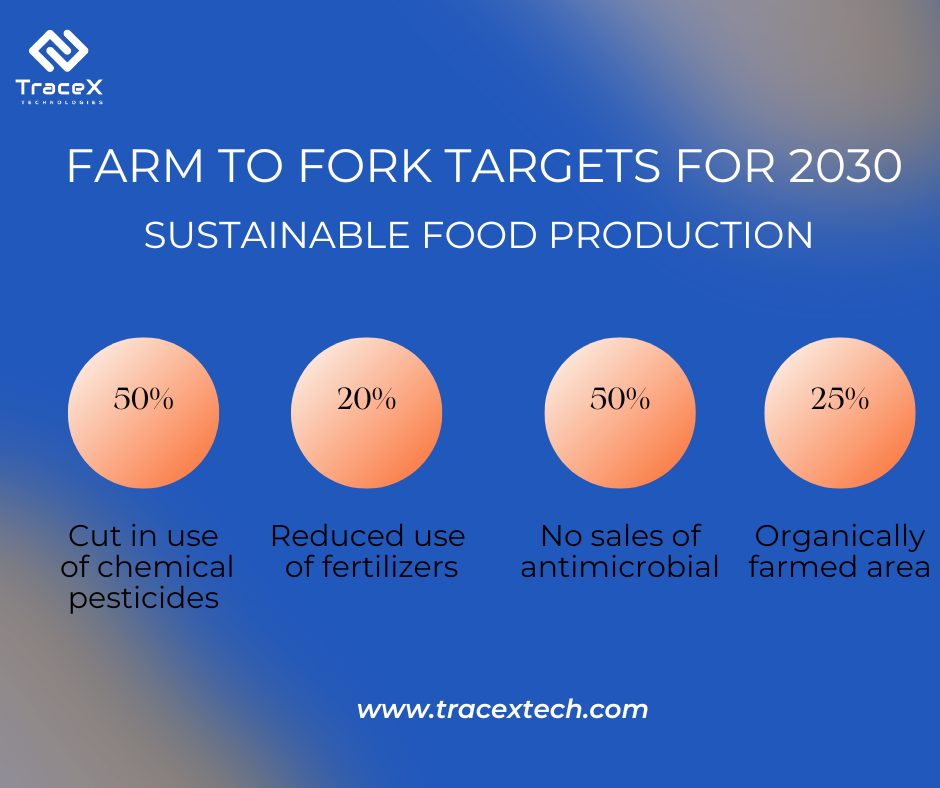Contact: +91 99725 24322 |
Menu
Menu
Quick summary: Explore the transformative impact of the EU's Farm to Fork (F2F) Strategy on the food supply chain. Discover how this ambitious plan integrates sustainability, addresses climate challenges, ensures fair practices, and empowers consumers. Dive into the nuances of F2F, shaping a more resilient, equitable, and environmentally conscious food system in the European market.

The European Green Deal, which aims to make food systems equitable, healthful, and environmentally sustainable, is cantered on the Farm to Fork Strategy. This groundbreaking initiative represents a comprehensive approach to revolutionize the entire food supply chain – from the cultivation of crops to the plates of consumers. Aimed at ensuring sustainability, reducing environmental impact, and promoting healthier food choices, the EU’s Farm to Fork Strategy is set to reshape the way we produce, process, and consume food.
The European Union carries substantial responsibility for its more than 400million citizens, from the production of food on farms and along the value chain all the way to dinner tables across its 27 members states.
Join us on a journey through the key components and implications of this strategy, exploring the transformative impact it holds for farmers, businesses, and consumers alike in the European market.
If food systems are not sustainable, they cannot withstand crises like the COVID-19 pandemic. Our current food systems need to be redesigned because they contribute nearly one-third of the world’s greenhouse gas emissions, use a lot of natural resources, reduce biodiversity, have a negative impact on health (due to both under- and overnutrition), and prevent equitable economic returns and means of subsistence for all parties involved, especially primary producers.
The Farm to Fork Strategy seeks to expedite the shift to a sustainable food system that should, among other things, have a positive or neutral environmental impact, aid in mitigating the effects of climate change and adapting to them, reverse the loss of biodiversity, ensure food security, nutrition, and public health, ensure that everyone has access to enough affordable, safe, and nutritious food, preserve food affordability while generating fairer economic returns, and foster fair trade.
The Farm to Fork Strategy, a cornerstone of the Green Deal, tackles the complexities of sustainable food systems, acknowledging the interconnectedness of human health, societal well-being, and environmental health. Aligned with the United Nations’ Sustainable Development Goals (SDGs), the strategy aims for a just transition that benefits all stakeholders in the food value chain, both within the EU and globally.
By 2050, the European Union wants to be carbon neutral. The Farm to Fork (F2F) and biodiversity policies are components of the European Green Deal, a political agenda aimed at bringing about the necessary transformation. The F2F strategy, which was released in May 2020, describes the EU’s plans to restructure the food system to make it “fair, healthy, and environmentally-friendly.” The supply (value chain), consumption, and primary production (farming) would all be a part of this future “farm to fork” food system. It shall have a neutral or positive environmental impact, help mitigate climate change, adapt to its impacts and reverse the loss of biodiversity, the European Commission has said
The EU aims to diminish the environmental and climate impact of its food system, enhance its resilience, guarantee food security in light of climate change and biodiversity decline, and spearhead a global shift toward competitive sustainability throughout the entire food supply chain, seizing new opportunities along the way.
Dive into a Greener Future!
Explore the keys to building sustainable food systems with our blog
Addressing global challenges, the sustainability of food systems is a pressing concern that demands adaptation. The EU, through this strategy, can take a pivotal role in establishing global standards. It outlines key targets for the entire EU, emphasizing the importance of both new policy initiatives and the enforcement of existing legislation. This includes measures for animal welfare, pesticide use, and environmental protection laws, all crucial for ensuring a fair and effective transition.
Encouraging sustainable and ecologically conscious food production requires reducing the use of antibiotics and pesticides in agriculture. An over-reliance on these chemicals puts ecosystems at serious risk since pesticides can contaminate water and soil, damage organisms that are not their intended targets, and encourage the growth of insect resistance. Similar to this, the widespread use of antibiotics in cattle ranching raises concerns for the health of both humans and animals by fueling the worrying growth of germs resistant to these drugs. Biological control, precision farming, organic farming and other integrated approaches are being used more frequently in agricultural practices to solve these issues. These tactics not only reduce the negative effects on the environment, but they also satisfy consumer demands for products with less chemical residues.
Uncover the Secrets of Integrated Pest Management!
Our blog delves into the world of sustainable agriculture practices, focusing on effective pest management.
Agriculture accounts for 10.3% of the EU’s greenhouse gas (GHG) emissions, with almost 70% originating from the animal sector, primarily non-CO2 GHGs like methane and nitrous oxide.
Furthermore, 68% of agricultural land is dedicated to animal production. The goal is to curtail the environmental and climate impact of animal farming, prevent carbon leakage through imports, and bolster the ongoing shift towards more sustainable livestock practices.
A sustainable and moral food system must prioritize protecting animal welfare and providing for farmers. Giving farmers access to resources such as financial support, technological advancements, and training—improves livelihoods while also enhancing agricultural practices and efficiency. Prioritizing animal welfare also entails putting humane agricultural methods into practice, providing animals with appropriate veterinary treatment, and providing suitable living conditions. By supporting these two goals, we meet consumer expectations for high-quality, ethically sourced goods while also promoting the welfare of farmers and a responsible and compassionate approach to food production.
The circular economy encourages recycling, reusing, and regenerating in an effort to reduce waste and increase resource efficiency. This concept promotes a closed-loop system where materials can be continuously recycled back into production by designing products with lifespan and recyclability in mind. The circular economy seeks to lessen its negative effects on the environment, preserve natural resources, and lessen the growing difficulties associated with waste management by giving priority to sustainable methods including product refurbishment, remanufacturing, and waste-to-energy projects. Adopting this strategy promotes innovation, resilience, and economic opportunities in addition to helping the environment become more sustainable as businesses and industries adjust to more resource-efficient and sustainable methods.

The EU’s Farm to Fork (F2F) Strategy is a comprehensive and ambitious plan aimed at transforming the food supply chain to be more sustainable, resilient, and equitable. This strategy encompasses various aspects that impact the entire journey of food from production to consumption.
By leveraging technology solutions, stakeholders across the food chain can address the challenges posed by the Farm to Fork Strategy more effectively, fostering a more sustainable and resilient food system.
Advanced technologies, such as blockchain, enable robust traceability throughout the food supply chain. This ensures transparency by allowing consumers and stakeholders to track the journey of food products from farm to fork. Traceability builds trust and confidence in the sustainability of the entire process.
Technologies like data analytics and digital monitoring systems provide farmers and stakeholders with real-time insights into agricultural practices. This data-driven approach helps in making informed decisions, optimizing resource use, and implementing sustainable farming practices.
Comprehensive farm management software from TraceX, allows farmers to plan, monitor, and manage their operations digitally. This includes tracking crop rotations, implementing integrated pest management strategies, and optimizing overall farm productivity while adhering to sustainability practices.
Technology helps in optimizing the entire supply chain, reducing inefficiencies, and minimizing waste. Smart logistics and inventory management systems contribute to a more sustainable distribution process, ensuring that food reaches consumers in a timely and efficient manner.
Technology facilitates direct communication between producers and consumers. Mobile apps, online platforms, and QR code scanning enable consumers to access information about the sustainability practices followed in food production. This engagement encourages more conscious and sustainable consumer choices.
New technologies are changing the agricultural scene by providing creative answers to different problems and improving sustainability. Using drones, sensors, and GPS, among other technologies, precision agriculture helps farmers maximize yields while reducing environmental impact and maximizing resource utilization. Machine learning and artificial intelligence support data-driven decision-making, maximize agricultural management, and forecast disease outbreaks. Modern indoor cultivation technologies, such as hydroponics and vertical farming, enable effective food production in cities without requiring a large amount of land. Blockchain technology solves issues with food safety and authenticity by improving supply chain traceability and transparency.
It is imperative to anticipate changes in legislative frameworks as global emphasis increasingly shift towards sustainability and ethical considerations. Regulations controlling agricultural and food production are expected to place a greater emphasis on consumer transparency, animal welfare, and environmental responsibility. More stringent regulations on the use of pesticides and incentives for the use of organic farming methods are two potential reforms. Regulators may also prioritize labeling and traceability more, making sure that consumers are fully informed about the source and methods of production of the food they buy. Incentives or laws may also be in place to encourage sustainable behaviours, such as conserving water and lowering carbon emissions.
In summary, there is a radical change taking place in the fields of agricultural and food production that is focused on sustainability, morality, and technological advancement. A growing number of stakeholders, from farmers to consumers, are realizing how critical it is to adopt policies that advance environmental stewardship, animal welfare, and transparency. Emerging technologies present promising solutions to improve efficiency and lessen environmental effect, even in the face of persistent problems including market access difficulties and economic pressures. Regulations are expected to alter, reflecting a global commitment to supporting ethical and sustainable farming methods. There is a growing movement toward a food system that not only guarantees a safe and sufficient supply of food but also gives ethical principles, environmental preservation, and consumer awareness more priority as people grow more knowledgeable and aware of their options and the well-being of all stakeholders.
